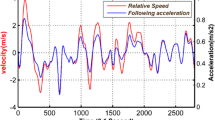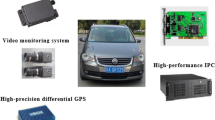Abstract
Car following modeling is one of the major issues in microscopic traffic simulation, and the accuracy and reliability of microscopic simulation models highly depend on the models. This research used a highly efficient method of regression for car following modeling such as support vector regression and compared it with multi-adaptive regression spline method as a nonparametric method. Meanwhile, the factors of “speed” and “distance to the following car” were used as the model’s inputs and it was proved that the accuracy of support vector regression model exceeded that of multi-adaptive regression spline. Driver’s reaction time is another unavoidable factor in car following modeling, which varies based on driver–vehicle features and traffic conditions. The research determines this value with respect to the time lag between the diagrams of the following and leading cars distance, the speed of the following car, and the execution of support vector regression model. The model was then implemented using the microdata of a highway traffic flow in the USA for 3 lanes. The research shows that the proposed model has a proper validity after entering driver’s instantaneous reaction time, which is based on the proximity of the results to the real condition of car following in simulation. A comparison was made between the simulations carried out using traditional models and the models proposed in this research. The results can be considered as a basis for other studies on car following modeling and microscopic traffic simulation in highway field.










Similar content being viewed by others
References
Aghabayk K, Sarvi M, Young W (2015) A state-of-the-art review of car-following models with particular considerations of heavy vehicles. Transp Rev 35(1):82–105
Ataei M, Osanloo M (2004) Using a combination of genetic algorithm and the grid search method to determine optimum cutoff grades of multiple metal deposits. Int J Surf Min Reclam Environ 18(1):60–78
Boer ER, Kenyon RV (1998) Estimation of time-varying delay time in nonstationary linear systems: an approach to monitor human operator adaptation in manual tracking tasks. IEEE Trans Syst Man Cybern Part A Syst Hum 28(1):89–99
Burrus CS, Gopinath RA, Guo H (1997) Introduction to wavelets and wavelet transforms. Prentice Hall, Upper Saddle River
Chang K, Chon K (2005) A car-following model applied reaction times distribution and perceptual threshold. J East Asia Soc Transp Stud 6:1888–1903
Chang C-C, Lin C-J (2002) Training v-support vector regression: theory and algorithms. Neural Comput 14(8):1959–1977
Colombaroni C, Fusco G (2014) Artificial neural network models for car following: experimental analysis and calibration issues. J Intell Transp Syst 18(1):5–16
Cortes C, Vapnik V (1995) Support-vector networks. Mach Learn 20(3):273–297
da Rocha TV, Leclercq L, Montanino M, Parzani C, Punzo V, Ciuffo B, Villegas D (2015) Does traffic-related calibration of car-following models provide accurate estimations of vehicle emissions? Transp Res Part D Transp Environ 34:267–280
Ding N, Zhu S, Wang H, Jiao N (2017) Following safely on curved segments: a measure with discontinuous line markings to increase the time headways. Iran J Sci Technol Trans Civ Eng 41(3):351–359
Elith J, Leathwick J (2007) Predicting species distributions from museum and herbarium records using multiresponse models fitted with multivariate adaptive regression splines. Divers Distrib 13(3):265–275
Friedman JH (1991) Multivariate adaptive regression splines. Ann Stat 19(1):1–67
Hastie T, Tibshirani R, Friedman J, Hastie T, Friedman J, Tibshirani R (2009) The elements of statistical learning. Springer, New York
He Z, Zheng L, Guan W (2015) A simple nonparametric car-following model driven by field data. Transp Res Part B Methodol 80:185–201
Hsu C-W, Chang C-C, Lin C-J (2003) A practical guide to support vector classification. University of National Taiwan, Taipei
Kalnins K, Jekabsons G, Rikards R (2009) Metamodels for optimisation of post-buckling responses in full-scale composite structures. In: Proceedings of 8th world congress on structural and multidisciplinary optimisation, Lisbon, Portugal
Milborrow S (2018) Notes on the earth package. http://www.milbo.org/doc/earth-notes.pdf
Misiti M, Misiti Y, Oppenheim G, Poggi J-M (1996) Wavelet toolbox. The MathWorks Inc., Natick
Ozaki H (1993) Reaction and anticipation in the car-following behavior. In: Daganzo CE (ed) Transportation and Traffic Theory. Proceedings of the 12th International Symposium on the Theory of Traffic Flow and Transportation. Elsevier, New York, pp 349–366
Poor Arab Moghadam M, Pahlavani P (2015) Moving objects trajectoty prediction based on artificial neural network approximator by considering instantaneous reaction time, case study: CAR Following. Int Arch Photogramm Remote Sens Spat Inf Sci 40(1):577
Poor Arab Moghadam M, Pahlavani P, Naseralavi S (2016) Prediction of car following behavior based on the instantaneous reaction time using an ANFIS-CART based model. Int J Transp Eng 4(2):109–126
Punzo V, Borzacchiello MT, Ciuffo B (2011) On the assessment of vehicle trajectory data accuracy and application to the Next Generation SIMulation (NGSIM) program data. Transp Res Part C Emerg Technol 19(6):1243–1262
Rahman M (2013) Application of parameter estimation and calibration method for car-following models, Master of Science Thesis. Clemson University, South Carolina
Saifuzzaman M, Zheng Z (2014) Incorporating human-factors in car-following models: a review of recent developments and research needs. Transp Res Part C Emerg Technol 48:379–403
Samui P (2013) Multivariate adaptive regression spline (Mars) for prediction of elastic modulus of jointed rock mass. Geotech Geol Eng 31(1):249–253
Samui P, Kurup P (2012) Multivariate adaptive regression spline and least square support vector machine for prediction of undrained shear strength of clay. Int J Appl Metaheuristic Comput 3(2):33–42
Smola A, Vapnik V (1997) Support vector regression machines. Adv Neural Inf Process Syst 9:155–161
Sun B, Wu N, Ge Y-E, Kim T, Zhang HM (2014) A new car-following model considering acceleration of lead vehicle. Transport (ahead-of-print) 1–10
Suykens JA, Van Gestel T, De Moor B, Vandewalle J (2002) Basic methods of least squares support vector machines. Least squares support vector machines. World Scientific, Singapore
Tang L, Qiu P, Schlinger CM, Yang G, Ye W (2016) Analysis of the influence of vehicle loads on deep underground excavation-supporting structures. Iran J Sci Technol Trans Civ Eng 40(3):209–218
Wang J, Hou R, Wang C, Shen L (2016) Improved v-support vector regression model based on variable selection and brain storm optimization for stock price forecasting. Appl Soft Comput 49:164–178
Wei D, Chen F, Zhang T (2010) Least square-support vector regression based car-following model with sparse sample selection. In: 2010 8th world congress on intelligent control and automation (WCICA), IEEE
Yang D, Jin P, Pu Y, Ran B (2013) Safe distance car-following model including backward-looking and its stability analysis. Eur Phys J B 86(3):1–11
Zheng J, Suzuki K, Fujita M (2013) Car-following behavior with instantaneous driver–vehicle reaction delay: a neural-network-based methodology. Transp Res Part C Emerg Technol 36:339–351
Author information
Authors and Affiliations
Corresponding author
Rights and permissions
About this article
Cite this article
Pahlavani, P., Poor Arab Moghadam, M. & Bigdeli, B. Car Following Prediction Based on Support Vector Regression and Multi-adaptive Regression Spline by Considering Instantaneous Reaction Time. Iran J Sci Technol Trans Civ Eng 43 (Suppl 1), 67–79 (2019). https://doi.org/10.1007/s40996-018-0141-0
Received:
Accepted:
Published:
Issue Date:
DOI: https://doi.org/10.1007/s40996-018-0141-0




